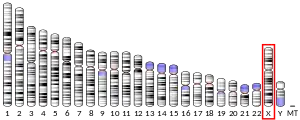ATP11C
ATP11C is an enzyme that in humans is encoded by the ATP11C gene.
Function
ATP11C encodes a member of the Type IV P-type ATPase family that is thought to transport or 'flip' aminophospholipids. The corresponding protein in mice is essential for the development of B cells and red blood cells,[4][5] and for the prevention of intrahepatic cholestasis.[6]
References
- GRCh38: Ensembl release 89: ENSG00000101974 - Ensembl, May 2017
- "Human PubMed Reference:". National Center for Biotechnology Information, U.S. National Library of Medicine.
- "Mouse PubMed Reference:". National Center for Biotechnology Information, U.S. National Library of Medicine.
- Siggs OM, Arnold CN, Huber C, Pirie E, Xia Y, Lin P, Nemazee D, Beutler B (May 2011). "The P4-type ATPase ATP11C is essential for B lymphopoiesis in adult bone marrow". Nature Immunology. 12 (5): 434–40. doi:10.1038/ni.2012. PMC 3079768. PMID 21423172.
- Yabas M, Teh CE, Frankenreiter S, Lal D, Roots CM, Whittle B, Andrews DT, Zhang Y, Teoh NC, Sprent J, Tze LE, Kucharska EM, Kofler J, Farell GC, Bröer S, Goodnow CC, Enders A (May 2011). "ATP11C is critical for the internalization of phosphatidylserine and differentiation of B lymphocytes". Nature Immunology. 12 (5): 441–9. doi:10.1038/ni.2011. PMC 3272780. PMID 21423173.
- Siggs OM, Schnabl B, Webb B, Beutler B (May 2011). "X-linked cholestasis in mouse due to mutations of the P4-ATPase ATP11C". Proceedings of the National Academy of Sciences of the United States of America. 108 (19): 7890–5. doi:10.1073/pnas.1104631108. PMC 3093471. PMID 21518881.
This article is issued from Wikipedia. The text is licensed under Creative Commons - Attribution - Sharealike. Additional terms may apply for the media files.

